Mexico's house prices likely to head down, as rates rise, violence escalates and Trump raves
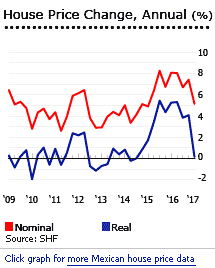 Mexico´s housing market is now slowing sharply, amidst weak demand caused by uncertainty about U.S. economic policies, combined with worries about corruption and violence.
Mexico´s housing market is now slowing sharply, amidst weak demand caused by uncertainty about U.S. economic policies, combined with worries about corruption and violence.
During the latest quarter nationwide house prices increased by 0.58%, but actually dropped 2.24% in real terms.
Mexico´s housing market has enjoyed nominal growth for a decade, but the real (inflation-adjusted) numbers are prosaic:
- In 2009, house prices rose by 4.75% (0.77% inflation-adjusted)
- In 2010, house prices rose by 3.7% (-0.59% inflation-adjusted)
- In 2011, house prices rose by 5.9% (2.37% inflation-adjusted)
- In 2012, house prices rose by 2.9% (-1.15% inflation-adjusted)
- In 2013, house prices rose by 4.07% (0.39% inflation-adjusted)
- In 2014, prices increased 5.11% (0.84% inflation-adjusted)
- In 2015, prices increased strongly by 6.75% (4.36% inflation-adjusted)
- In 2016, house prices rose by 7.41% (4.07% inflation-adjusted)
The nationwide house price index rose by 5.16% during the year to Q1 2017, after y-o-y rises of 7.41% in Q4 2016, 6.7% in Q3 2016, 8.05% in Q2 2016 and 8.08% in Q1 2016, according to the SociedadHipotecaria Federal(SHF). However, when adjusted for inflation, house prices rose by a miniscule 0.17%, far from Q1 2016´s real growth of 5.26%.

Demand is falling. Urban housing transactions fell 6.1% y-o-y to 474,592 units in 2016, according to the Housing Finance Information Network (HOFINET).Construction activity is also slowing. Housing completions fell by 4% to 282,588 units in 2016.
The slowdown is greater from the perspective of foreign homebuyers, because of the peso´s sharp depreciation. In 2015, Mexico´s peso slumped against the US dollar by about 15%, the biggest annual decline since 2008. The peso depreciated by a further 9% from December 2015 to May 2017,to MXN18.7674 = USD1.
House prices are expected to be weak for the remainder of the year, given low confidence, the uncertainty about U.S. economic policies, and tightening monetary policy.
The Mexican economy grew by 2.8% in Q1 2017 from a year earlier, up from 2.3% growth the previous quarter, according to the InstitutoNacional de Estadistica y Geografia (INEGI). The economy is expected to expand by between 1.5% and 2.5% this year, after growth rates of 2.3% in 2016, 2.6% in 2015, 2.3% in 2014, 1.4% in 2013, 4% in both 2011 and 2012, and 5.1% in 2011.
Constitutional ban on foreign land ownership remains
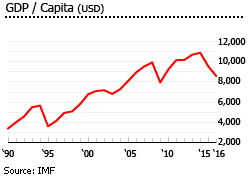
Under the current system of fideicomiso, foreigners can only indirectly own real estate by setting up bank trusts. While the trustee is the legal owner of the real estate, the beneficiary retains all ownership rights and responsibilities and may sell, lease, mortgage, and pass the property on to heirs. The fideicomiso is authorized by the Mexican Government under the Ministry of Foreign Affairs.
Although this system is relatively safe, it rests on the credibility of Mexico´s banking system and property registry administration, which unfortunately discourages many foreigners.
There were hopes that the restrictions might be loosened up. Congress actually voted in favor of a proposal to allow foreigners to directly purchase beach residences. However, this proposed legislation was rejected, due to the amendment procedure not being finished within the time frame required by Article 89 number 2, Section III of the Rules of the Chamber of Deputies. So fideicomiso is still the system foreigners must use.
Small mortgage market; high interest rates
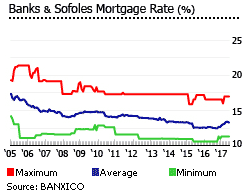
The central bank Banco de Mexico (Banxico) raised its key rate for the seventh straight time in June 2017, amidst increased inflationary pressures and after the Fed raised its interest rates. Banxico raised its key rate by 25 basis points to 7% in June 2017 - the highest level in eight years.
The non-subsidized private mortgage market in Mexico is small, at around 9.9% of GDP in 2016 - only slightly up from 8.6% of GDP in 2007. Mortgage interest rates remain high. The average interest rate offered by banks and Sofoles was 13.3% in May 2017, slightly up from 12.62% in the same period last year.
In March 2017, mortgage lending rose 8.7% to MXN2.15 trillion (US$120.91 billion) from a year earlier, according to the central bank.
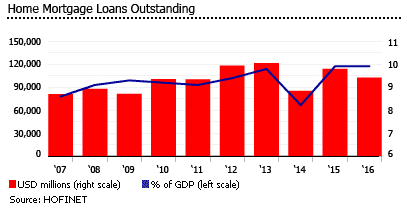
Since 2000, banks have made significant changes that have led to better access to loans, and more favourable lending conditions.
- Mortgage processing fees have been reduced to an average of 3%, from 6%.
- Loan to value ratios have been raised to 80% - 90% from 65% or lower.
- Loan terms have been lengthened from 10 - 15 years in 2000, to the current level of up to 30 years.
Local house price variations
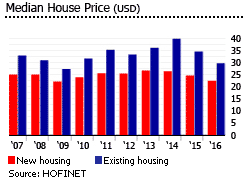
Whatever the short-term hiccups, there is an enormously strong housing market in Mexico.
The Mexican market is not driven by speculators. There are many developers, it is highly competitive. Much new housing is built, which keeps prices down. Interest rates are (relatively) low in the social sectors, due to subsidies. Home prices in Mexico rose by 6% annually between 2005 and 2016, according to SHF´s home price index. The last big housing crisis occurred after the Tequila crisis of 1994, when a currency devaluation followed by interest rates spiking caused 40% of all bank loans to default. Since then, there has been continuous growth.
Mexico´s most expensive houses are in the municipalities of San Pedro Garza Garcia in Monterrey Metropolitan Area, in Zapopan in Guadalajara Metropolitan Area, and in Acapulco, according to Lamudi. High-end apartments cluster in Miguel Hidalgo municipality in Mexico City, San Pedro Garza Garcia in Monterrey, and Huixquilucan in MexicoState.
In Polanco, one of Mexico City´s most exclusive neighborhoods, luxury apartments cost around US$2.5 million to US$10 million. Residential property pricesaveraged around US$5,000 per square metre (sq. m.) in 2016, but can reach as high as US$11,000 per sq. m. for the most expensive properties, according to Carmella Peters Romero of Peters & Romero BienesRaices.
In nearby Lomas de Chapultepec, an area with older, traditional homes, prices of luxury properties start at US$3 million, said Karen Boda of URP Properties. In Bosque de las Lomas, less expensive luxury homes are available at prices ranging from US$800,000 to US$3 million.
Mexico City´s most expensive homes, which are typically located in Lomas de Chapultepec in the north and in El Pedregal and Coyoacán in the south, are priced at US$10 million to US$15 million, Boda added.
In Playa del Carmen, a coastal resort town along the YucatánPeninsula´s Riviera Maya, two-bedroom beachfront apartments are priced from US$550,000, according to Liszett Torres of Sotheby´s International Realty. In Playacar, a gated community of resort developments in Playa del Carmen, a four-bedroom home with an infinity pool lists for US$2 million.
In Tulum, another resort town located in Mexico´s Caribbean coast, a two-bedroom penthouse in the exclusive gated community of AldeaZamá, is priced about US$300,000. To the south, a four-bedroom villa is priced at US$3.9 million. To the north, in TankahBay, a five-bedroom seafront villa with a pool is listed for US$1.6 million.
In Cancún, a city in southeastern Mexico known for its beaches, mega-resorts, and frenetic nightlife, prices for four-bedroom villas with a pool range from US$1.4 million to US$3 million.
Rental yields are moderately good
Gross rental yields in Mexico City - the return earned on the purchase price of a rental property, before taxation, vacancy costs, and other costs - are moderately attractive.
In previous years, Global Property Guide found that rental yields in Mexico City were moderate, at between 4.9% and 5.4%. To buy a 120 square metre (sq. m.) apartment in an upscale area of Mexico City costs around USD 3,000 per sq. m., or USD 350,000 - a not unreasonable price.
Luxury market buoyed by both foreign and domestic demand
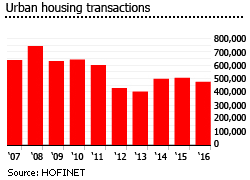
Mexico´s real estate market has been buoyed by strong demand in resort communities, according to the International Consortium of Real Estate Associations (ICREA). American and Canadian buyers are returning to Mexico, after a several-year slump, thanks to low oil prices and the strong US dollar, pushing home values up.
American buyers are very important as owners of beachfront properties, which were badly affected by the slump of 2009-10 in areas like Baja California Sur, Nayarit, Baja California, Guerrero and Sinaloa.
The rising middle class
Between 2000 and 2010 Mexico´s middle-class grew from 37 million to 44 million (INEGI, 2013). Last year, the country´s middle class was estimated to account for almost half of the total households, at 14.6 million.
The middle class is expected to continue growing, with about 3.8 million more households projected to move into the middle class by 2030, for several key reasons:
First, inflation has halved: it was close to 10% in 2000, but between 2015 and 2016 the rate has hovered around 2.8%. The autonomy of the Bank of Mexico has played a key role.
Second, there is now trade openness. As a percentage of the economy, foreign trade (exports plus imports) accounts for nearly 60% of GDP, making Mexico one of the most open economies in the world. By way of comparison, the figure is 27% in Brazil, 48% in China and 30% in the United States. This is fosters competition and puts an upper limit on the price of goods in the local market.
Third, there is the prudent management of public finances. There is no significant pressure on the fiscal balance or public debt. Between 2000 and 2012, the fiscal deficit was at levels below 1% of GDP. The headline fiscal deficit is expected to hover around 2.4% this year, from 3% in 2016. Total public debt, domestic and foreign, remains below 50% of GDP in 2016.
The last component is financial inclusion. The population using banking services rose from 33 million in 2006 to 51 million in 2012, marking an annual average growth rate of 7.5%. In 2016, about 44% of adults in Mexico own a bank account, according to the Encuesta National de Inclusion Financiera. Last year, the government also launched the National Financial Inclusion Strategy (NFIS), which aims to accelerate access to financial services for the more than half of the population currently left out of the formal and regulated financial system.
Effect of violence on the housing market

Although drug-related violence has been present in Mexico for the past three decades, the government passively ignored the problem from the 1980s to early 2000s. This norm was broken when President Felipe Calderon took office in 2006 and implemented a militarized approach to dealing with the drug cartels.
Calderon may have been partially successful, but around 60,000 people were killed during his campaign against drug cartels. News about drug-related violence turned off potential American baby-boomer home-buyers.
A BBVA study has suggested that violence has only a limited effect on domestic housing sales, because the violence is very regionally concentrated. Almost half of the homicide cases every year occur in Baja California, Durango, Sinaloa, Chihuahua and Guerrero, according to the SSP (Secretaría de SeguridadPublica or Public Security Ministry). Plus, low income segments account for 80% of the housing market. The key issue for this segment is housing finance and housing supply, not violence, to which their communities are less vulnerable.
However, violence has climbed to new highs recently. President Enrique Peña Nieto´s (2012+) rhetoric has focused on lowering murder rates, kidnappings, and extortions, as opposed to arresting or killing the country´s drug lords. He announced the creation of a large national centralized police force, but then retreated from that announcement.
In Q1 2017, there were a total of 5,775 homicides recorded around the country, up 29% from the same period last year and the highest number of killings in the start of any year in the past two decades, according to government figures.
The southwest state of Guerrero, home of the once idyllic resort city of Acapulco, had the highest homicide cases in Q1 2017, with 550 cases. On the other hand, Baja California Sur had the biggest year-on-year rise during Q1 2017, with the number of homicide cases rising almost 7 times to 133.
The PRI then and now
Enrique Peña Nieto of the Institutional Revolutionary Party (PRI) won the 2012 presidential election. The PRI ruled for Mexico for an extraordinary 71 years until 2000, ceding for a 12-year period to the free-market/Christian Democratic National Action Party (PAN).
In its heyday, the PRI controlled the Presidency, the Senate, the House of Representatives, the Supreme Court, almost all governorships and mayoralties throughout the country. It controlled all labour unions, all peasant organizations, all student organizations. Employer organizations were affiliated to the Mexican state.
Opposition was met with a combination of incorporation, and death squads. There was much electoral fraud.
Mexico had an economic miracle from 1940 to 1970 based on import-substitution, when GDP increased sixfold, while the population only doubled. GDP growth rates were over 5% or 6% per annum. But in later years Mexico did not grow fast enough to keep up with countries like Brazil and Indonesia, while oil revenues allowed the state to spend heavily on social programs and industrialization, in an atmosphere of increasing corruption and inefficiency.
Many Mexicans became disaffected during the 1970s and 80s. President Ernesto Zedillo´s (1994-2000) devaluation of the peso in 1994 (the "Tequila crisis") turned the following years into a severe crisis, further undermining support for the ruling party.
The Mexican peso crashed. The downturn precipitated an enormous banking and property crisis. Yet the Mexican economy improved after the crisis, with average growth of 5.1% from 1996 to 2000.
The good years
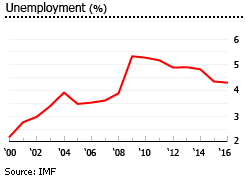
Economic expansion continued under the free-market/Christian Democratic National Action Party (PAN) after 2000. By 2002 Mexico´s banks had been recapitalized. The housing market had solider financial foundations. Interest rates began to fall, and lending for housing recommenced.
Mexico experienced extraordinary growth of its housing market during the following years (2002-2007). Inflation was now relatively low, and construction began to recover. More people began to borrow to buy houses, largely due to a big increase in government low-cost housing schemes. The ratio of self-built houses fell from 70% in 2000, to 30% of new houses in 2006. Construction became one of the economy´s most dynamic sectors, boosted by lower interest rates. Bank loans rose.
Reforms helped: better mortgage laws, social security reform with a defined contribution system fostering long-term savings, the creation of a long-term yield for government securities.
House prices remained restrained all through this period, because the housing construction sector had become much more competitive, and many more developers were building housing. The wider economy also grew, and exports were very strong.
Nieto and PRI´s return to power
Mexico by 2012 was a deeply stressed country. A major reason was undoubtedly that in 2006, Calderón chose to make the battle against organized crime the centerpiece of his presidency.
By 2012 many Mexican citizens were tired of the fight they had first supported, with over 60,000 dead.
In late 2012 the PRI´s Nieto (called by many "the new face of the old guard") became president. He promised big changes, and was initially feted by investors.
More than four years after taking office, Nieto is now struggling to keep his political head above water amidst the fallout from ongoing corruption scandals, escalating violence, and a series of political missteps. In fact, many suspect Nieto of intending to re-establish the PRI´s old corrupt hegemony.
Nieto has been involved in two housing scandals. The first was the revelation that first lady Angelica Rivera´s US$7 million house in Lomas de Chapultepec was registered under the name of a construction company property that received contracts in the state of Mexico when Nieto was governor. The second came after in November 2014 a high-speed train contract was awarded to a Chinese-led consortium. The contract was later scrapped when it was revealed that the president´s White House family mansion had been paid for by a contractor who was a member of the train consortium.
The PRI won 203 out of 500 seats in the Chamber of Deputies in the June 2015 elections - remaining the dominant party. Along with its two allied parties, the Ecologist Green Party of Mexico (PVEM) and New Alliance Party (PANAL), the three ruling parties hold 260 out of 500 seats and garnered 39.84% of votes. Following PRI was PAN, with 108 seats, and the Party of the Democratic Revolution (PRD) with 56 seats.
The next general elections will be held in July 2018.
Modest economic growth
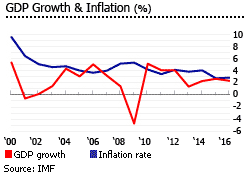
The Mexican economy grew by a modest 2.8% in Q1 2017 from a year earlier, up from 2.3% growth in the previous quarter, according to the InstitutoNacional de Estadistica y Geografia (INEGI). The country´s economic performance has been improving recently, but uncertainty remains over U.S. economic policies and the shape of the renegotiation of the North American Free Trade Agreement (NAFTA), expected to start in August.
The U.S. is the country´s main trading partner, accounting for US$303 billion or 81% of its total exports last year. Likewise, Mexico is the U.S.´ second largest goods export market in 2016, primarily importing machinery, vehicles, fuels, plastics, and agricultural products.
After a 4.7% GDP contraction in 2009, Mexico grew by 5.1% in 2010 as export demand picked up, specifically from the United States. This was followed by good years in 2011 and 2012 (both with 4% growth).
Mexico´s economy is highly dependent on the US, and in 2012, 78% of Mexico´s exports went to the US. 2013 was a disappointing year with 1.4% GDP growth, but in 2014 there was 2.3% GDP growth. The economy grew by a modest 2.3% last year, slightly down from 2.6% growth in 2015.
Mexico´s 2017 economic growth outlook was recently raised to a range of 1.5% to 2.5% by the central bank, Banco de Mexico, from the previous target of 1.3% to 2.3%, due to improving economic conditions. On the other hand, BBVA Research expects the Mexican economy to grow by 1.6% this year, citing three factors for its growth projection:
- Slowdown in private consumption growth;
- Weakness in gross fixed capital formation (GFCF); and
- Growth in export sector.
In May 2017, consumer prices rose 6.2% from a year earlier, up from 5.8% in the previous month and the highest since early 2009. This was also considerably above the central bank´s 3% to 4% inflation target for 2017.
Mexico´s unemployment rate stood at 3.6% in May 2017, slightly up from 3.5% in the previous month but down from 4% a year earlier, according to INEGI.